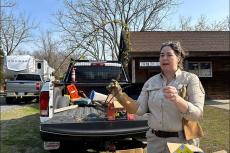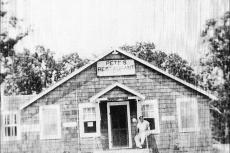This photo, taken in 1999 during a tour of the Gardiner Mill, shows its inner gears. The present-day Gardiner Mill was constructed in 1804 on the eastern side of Town Pond, just south of St. Luke’s Episcopal Church. A previous mill, built near the same place in 1769, was replaced by the more technologically advanced 1804 smock mill design.
Smock mills rotate only the mill’s cap to face the wind, rather than the entire body of the mill. The tooth-like cogwheel seen here would catch the pins in the other wheel, rotating both wheels as part of the mechanism turning the millstone. The 1804 Gardiner Mill’s design allowed two gristmills to run at the same time, doubling flour production.
Construction occurred between June 11 and Sept. 28 of 1804, according to the meticulous records of John Lion Gardiner (1770-1816). While Nathaniel Dominy V (1770-1852) receives credit for crafting the mill, he certainly had help from several local residents, including Capt. David Hedges (1770-1840), Miller Dayton (circa 1766-1847), and a free person of color, Isaac Plato (circa 1767-1833), who helped receive its pieces.
Plato received the mill shaft for Gardiner and his shareholders around April 16, 1804, according to the account books. Plato’s name regularly appears in Gardiner’s books, and he seems to have bought land near Springs. He can be found as a witness in town records and is one of the few people of color listed on the early East Hampton Town tax rolls.
For those interested in learning more about Isaac Plato, Laini Farrare, a McNeil Fellow from the Winterthur Program in American Material Culture, will speak about him on Saturday, May 11, at 11 a.m. at the East Hampton Library as part of a presentation on African-American craftspeople of eastern Long Island and connections to the Dominy family. Sign-up is on Eventbrite.
Andrea Meyer, a librarian and archivist, is head of collection for the East Hampton Library’s Long Island Collection.




